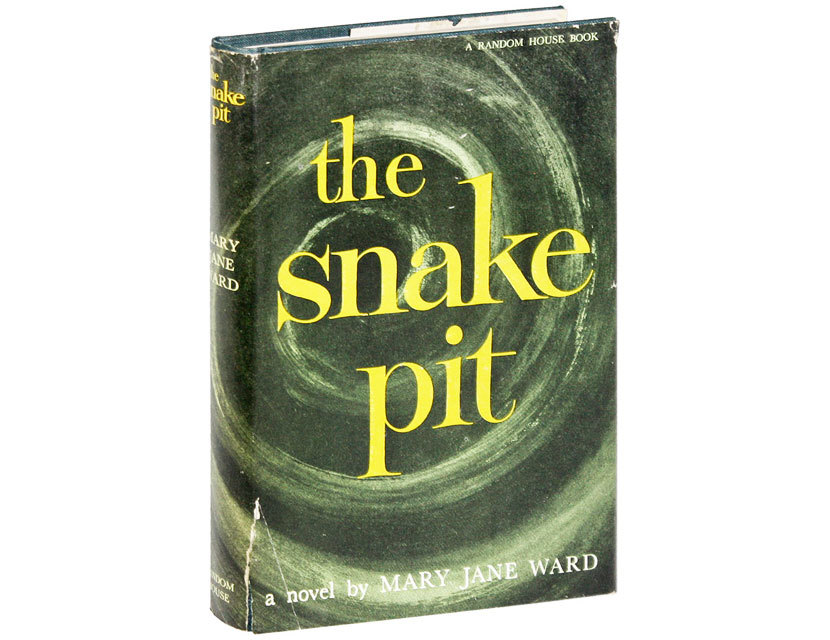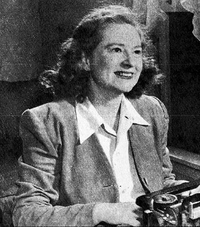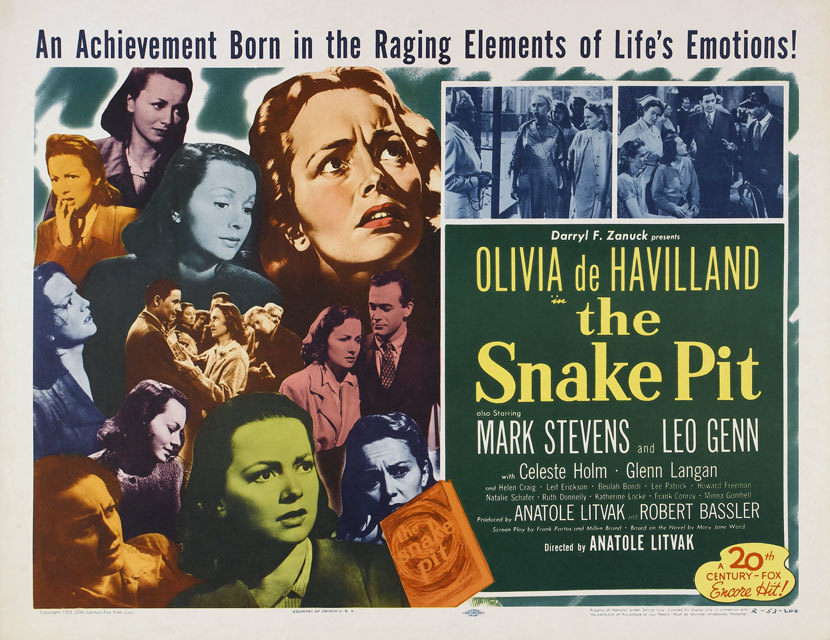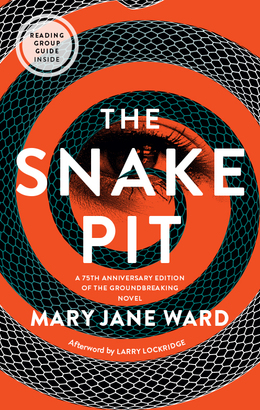This spring Library of America reissued Mary Jane Ward’s 1946 novel The Snake Pit on its seventy-fifth anniversary. Based on Ward’s own nightmarish experiences as a patient in a New York State psychiatric hospital, the novel wasn’t just a huge commercial success and the basis for an acclaimed Hollywood movie; it also prompted a nationwide public reckoning with the care given to the mentally ill.
Library of America’s new edition of The Snake Pit includes an afterword by Larry Lockridge, Professor Emeritus of English at New York University and the author of several nonfiction books (including a prize-winning biography of his father, the novelist Ross Lockridge, Jr.) as well as a series of novels, The Enigma Quartet. He is also related to Mary Jane Ward, who was his father’s cousin.
In the following interview with Library of America Editorial Director John Kulka, Lockridge shares some additional insights into The Snake Pit, its author, and its continuing relevance in twenty-first-century America.
John Kulka, Library of America: Until Library of America recently reissued Mary Jane Ward’s The Snake Pit, it had been out of print for decades. I’d guess if readers recognize the title at all anymore, they connect it with Anatole Litvak’s 1948 film adaption of Ward’s novel, which stars Olivia de Havilland in the lead role. It’s always a bit mysterious why a book—a good one, anyway—falls into oblivion, but in this case it’s especially perplexing given the novel’s undeniable impact on the care of the mentally ill. It’s credited with putting in motion important investigative journalism at midcentury that ushered in legislation to reform America’s languishing psychiatric hospitals and mental wards.
But the novel had a kind of outsized literary impact, too, in terms of its influence on novels about mental illness. Some readers note similarities between Ken Kesey’s Nurse Ratched and one of the nurses in Mary Jane Ward’s novel. Sylvia Plath in her journals talked explicitly about using Ward’s novel as a model for The Bell Jar. Can you expand on the novel’s influence—and do you have any thoughts about why it has been out of print for three decades?
Lockridge: Yes, it’s puzzling that The Snake Pit has been out of print for three decades, given its large social influence and intrinsic literary merit. Bennett Cerf at Random House initially tried to get Mary Jane Ward to change the title. “Women buy most of the novels—and they hate snakes!” He was later glad she stood her ground, recognizing that “snake pit” had become part of our language as a metaphor for institutional indifference, ignorance, and cruelty, especially in mental institutions. Like The Jungle before it on meatpacking and food industries, The Snake Pit led to institutional reform of asylums and greater public tolerance of mental illness, with legislative changes of mental health policy in twenty-six states.
Its direct literary influence can be seen in One Flew Over the Cuckoo’s Nest and The Bell Jar, among others. Sylvia Plath writes of it in her journals, as you say, and was quite moved by the film adaptation. The Snake Pit may be a mainstream novel, a bestseller in its day, but it challenges much of what creative writing students are taught about characterization, plot, and a consistent point of view. From the beginning the reader is thrown into a disorganized mind where point of view shifts from first to second to third person and back again within a paragraph or two. The first chapter especially presents mental disorientation as linguistic instability. Signet, which brought the novel out in paperback, asked Mary Jane to please drop the chapter. She declined.
This is not to suggest the novel is postmodern—for one thing, it’s readable—but I feel it would enhance collegiate syllabi for having formal as well as psychological value in its lack of what linguists call stable deixis or stationing. What instructor wouldn’t enjoy holding forth on deixis? One sign that Virginia Cunningham may be partially recovering her sanity is that in later chapters there is greater linguistic stability. In this particular aspect of language use, the novel differs from other mainstream novels as well as from titles of the subgenre it largely founded, the asylum novel.

Kulka: The Snake Pit is a work of fiction, but it is drawn from Mary Jane Ward’s own experiences with mental illness after she spent time in a psychiatric hospital following a breakdown. Tell our readers something about the author’s struggle with mental illness and how it informs the novel. After the publication of The Snake Pit, Mary Jane Ward became the foremost spokesperson in America for mental health reform, is that right?
Lockridge: Imagine how you would feel if an intimate were of a sudden to make no sense in her speech. Mary Jane’s husband, Edward Quayle, was filled with terror when his highly literate wife of thirteen years began speaking gibberish. He was hearing the disorganized speech commonly called “word salad,” an unsavory term. This was the symptom that first presented in each of Mary Jane’s four breakdowns requiring hospitalization over the years. According to Edward, she was routinely diagnosed as schizophrenic—the most probable diagnosis, though bipolar illness can also present with disorganized speech in a manic episode. She spent eight-and-one-half months—June 5, 1941, to February 22, 1942—in an upstate New York hospital, the fictional Juniper Hill in the novel.
It’s one sign of its modernity that the novel doesn’t offer a diagnosis, only an obvious misdiagnosis along Freudian lines that is sent packing. In an unpublished memoir, Mary Jane describes her childhood as unusually happy, growing up in small-town Fairmont, Indiana with caring parents, lovable grandparents, and good friends. An excellent student and talented pianist, she began writing stories in little notebooks at an early age, had already published two well-received novels with Dutton, was happily married and had left Evanston for Greenwich Village when stricken with a disconnect from reality, which she described as “sudden, acute . . . quite without warning.” There were some economic and wartime stressors but nothing that could account for her illness and no early trauma that had resurfaced as psychosis.
Upon her rise to fame in 1946, she undertook to educate the American public about the condition of mental institutions, especially state institutions, visiting and evaluating more than two hundred, giving speech after speech, and consulting with mental health professionals such as Karl Menninger. In 1949 Harry Truman presented her—along with Eleanor Roosevelt and Grandma Moses—with a “woman of achievement” scroll that he autographed. She continued her mission for the next seven years, a labor that ironically led to another breakdown. As she wrote to Bennett Cerf, “My second breakdown terminated the activities that were literally killing me.”

Kulka: Larry, our readers may be interested to know that you are related to Mary Jane Ward, and that you knew her. I wonder if you would share something about your relationship with her.
Lockridge: My father was Ross Lockridge, Jr., author of the 1948 novel Raintree County and Mary Jane Ward’s double second cousin. He had become acquainted with Mary Jane, nine years older, early on, but they became close only in 1946 when publication of The Snake Pit coincided with my father’s first drafting of a 2,000-page manuscript, getting it accepted by Houghton Mifflin, soon thereafter winning the MGM Novel Award, having an episode excerpted in Life magazine, and learning his novel would be Main Selection of Book-of-the-Month Club for January, 1948.
During these months Mary Jane and he engaged in an intense correspondence and saw each other frequently. By the last two of these visits, my father had fallen into a clinical depression from which he never recovered, ending his life by suicide in March, 1948, just as Raintree County—his attempt at the Great American Novel—topped the nation’s best-seller lists. It is a deep irony that Mary Jane Ward, by then the chief national spokesperson on mental health issues, was unable to help her own cousin, who was suffering, she had thought, only a bad case of nerves brought on by overwork.
After my father’s death, she and Edward visited my family annually in Bloomington while they still lived in the Evanston area. I came to know both of them well. Mary Jane was always cheerful and articulate. One would never have thought she suffered from an illness that would recur three more times after her Snake Pit days.
Kulka: In your Afterword, you talk about the humor in Ward’s novel, a quality that might surprise readers expecting to find in a novel about mental illness nothing but gloom and despair. More particularly, you note the striking parallels between The Snake Pit and Lewis Carroll’s Alice’s Adventures in Wonderland. Would you expand on those comments?
Lockridge: It isn’t my own critical insight that The Snake Pit has much in common with Alice’s Adventures in Wonderland. Mary Jane pointed this out herself in a severe critique of the initial 20th Century-Fox screenplay, which she thought lacked the novel’s humor, a serious shortcoming.
The novel is primarily an adventure story. The protagonist’s adventures in a mental hospital are as strange and weird to her as Alice’s in Wonderland . . . When we laugh at the antics of the insane we can be laughing in sympathy. In our hearts we know we are laughing at ourselves. What humor the novel has was put in deliberately to provide the readers with relief and to strengthen reader contact.
Analogues are rife. Virginia sits at the dinner table with ladies who chant “Save some for Virginia,” only to pass her a nearly empty bowl. She can’t learn the difference between a wet dry mop and a dry wet mop. She plays bridge with the ladies and “you could change trumps any time you felt like it,” just as there are no rules on the Queen’s croquet ground. Like Alice, Virginia comes up for trial—a staff meeting that will decide whether she will be set free or punished further, and she doesn’t even know what the charges are. The Snake Pit is as Kafkaesque as Alice’s Adventures in Wonderland. It’s a dark comedy.

Kulka: Ward worked as a consultant to the 20th Century-Fox adaptation and spent some time in Hollywood in the company of Olivia de Havilland and Anatole Litvak. Litvak’s departures from the novel are interesting—I’m thinking especially of the way he chooses to portray Virginia’s psychiatrist, Dr. Kik, and the film’s ending. Did Ward understand these departures? Were there aspects of the film she didn’t like?
Lockridge: The film, first-rate on its own terms as most critics agree, is a total misrepresentation of the novel in revealing ways. The departures, some of which I’ve touched on already, are many. The novel doesn’t specify a diagnosis of Virginia’s illness. The reader is simply thrown into a world of mental disequilibrium where the heroine doesn’t know who or where she is or why she is there. If they have an interest in psychological diagnosis, readers may decide for themselves what ails her. Her psychiatrist, the shadowy character Dr. Kik, is a resolute Freudian who thinks Virginia suffers guilt over marrying Robert two years after her engagement with his best friend Gordon ended with the latter’s death. Mary Jane struck from her typescript, “Dr. Kik is crazy,” but Robert and she both find Dr. Kik’s diagnosis absurd. Mary Jane noted in her critique of the screenplay that many women widowed in World War II found “new love.” The film, however, makes this diagnosis the master key to Virginia’s illness, adding a childhood trauma involving a mutilated doll, her father and his own death. Dr. Kik, far from shadowy, becomes a central character.
Mary Jane, serving as an unpaid consultant on set leading up to the shooting, feared that Gregory Peck might be cast as Dr. Kik, and the film would sink into sex “because all the ladies are in love with him.” As it turned out, the role was played by relatively lackluster Leo Genn, but Olivia de Havilland still subtly makes it clear that Virginia has fallen for her psychiatrist. At the film’s conclusion Virginia tells Dr. Kik that she knows she is cured because she is no longer in love with him. Dr. Kik replies, “But Virginia, you never were,” as classical transference theory would have it. The novel ends with no such exchange, and Mary Jane leaves the question open as to whether Virginia is cured or not.
She also objected that the film gives the false impression that psychiatrists are deeply involved in individual patient care. But she became reconciled with the distortions—this was Hollywood, after all, and the film was instrumental in making mental health care an international issue. Her novel, translated into sixteen languages, and the film were both widely acclaimed abroad.

Kulka: Thank you for your time, Larry. Any closing words you would like to add?
Lockridge: I’m glad Library of America has brought The Snake Pit back into print. It’s overdue for a reassessment. The novel remains timely in an era of mental instability writ large and remains an engrossing read from beginning to end.




